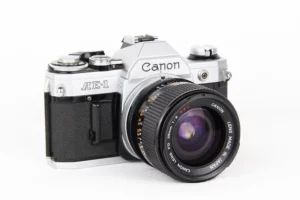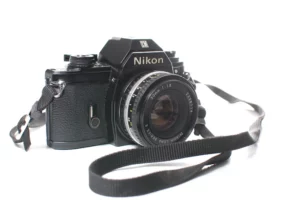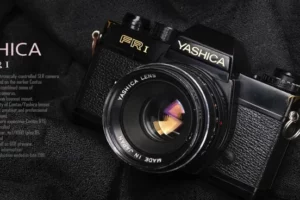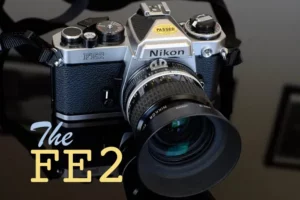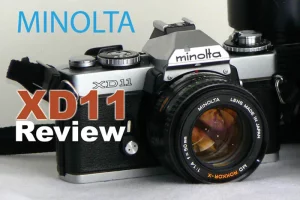Contax 137 MD: What can the cheapest Contax camera do?
Last Updated on January 28, 2023
The origins of the name Contax go back to the 1930s. After Oskar Barnack had been working on a 35mm camera for Leitz since around 1913, which then came onto the market under the name Leica in 1925, the big competitor Zeiss Ikon also wanted to produce such a camera.
But it was not until 1932 that Zeiss Ikon presented a rangefinder camera that could compete with the Leica. Unlike Leitz, Zeiss Ikon wanted their top model to have a special name, unlike other cameras: Contax.
The first model, simply called “Contax”, shows its age today, but the camera already contained a lot of what is also found in a Leica M6, for example.
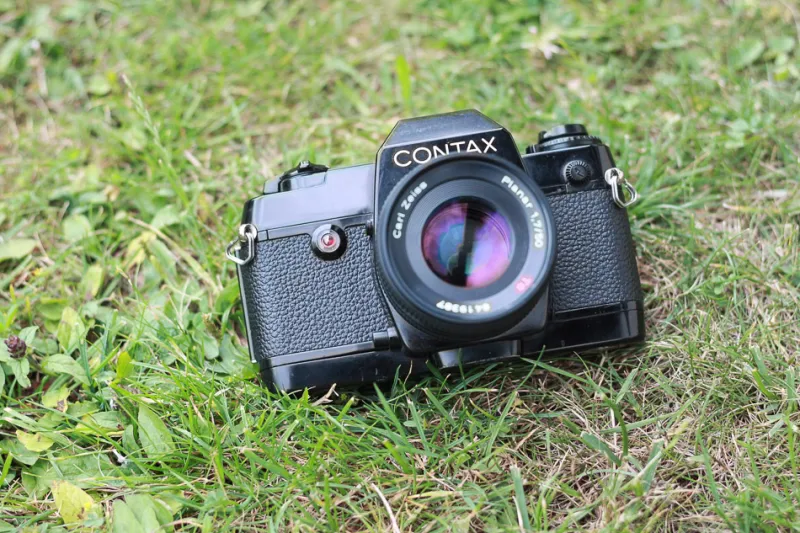
Table of Contents
Contax 137 MD Specs
| Frame format | 35mm, 24x36mm |
| Lens bayonet | Contax / Yashica (C/Y) |
| Shutter | Electronically controlled, vertical-travel fabric focal plane shutter with quartz timer |
| Shutter speeds | Semi-continuously variable from LT (11 sec.) to 1/1000s in automatic mode + Bulb (manual) |
| Flash sync | 1 / 60s |
| Electronic self-timer | Quartz-controlled, electronic self-timer (10 sec.) with flashing LED |
| Trigger | Electromagnetic “Real-Time” release (quartz controlled), connection for standard remote release cable |
| Exposure control | Centre-weighted average light metering through the lens (TTL) at full aperture using the SPD sensor. |
| Operation mode | Aperture priority only, exceptions: X-Sync + Bulb |
| Sensitivity range | EV 0 to 18 (ASA 100 with f/1.4 lens) |
| Film speed range | ASA 12 to 3200 |
| Exposure metering system | Activated with on/off switch |
| Exposure Compensation | possible from -2 to +2, locks in at full f-stops, but intermediate steps can also be used |
| Reading memory | AE lock is activated when the on/off switch is turned one position further |
| Flash exposure control | Automatic control when using the Contax TLA flash at 1/60s, otherwise manually via X-Sync |
| Viewfinder | Silver-coated pentaprism viewfinder with split image indicator / microprism ring, 95% coverage, viewfinder magnification 0.86x (with 50mm lens) |
| Viewfinder display | LED display of the shutter speed + over/underexposure display, display of the flash intensity setting, aperture scale, frame counter, LED to display the exposure compensation, with AE lock the LED of the time display flashes |
| Film transport | fully automatic by built-in micromotor |
| Burst speed | 2 frames per second |
| Frame counter | one counter each on the housing and in the viewfinder |
| Accessory shoe | Hot shoe with center contact |
| Camera back | with film holder, interchangeable with data back panel |
| Battery check | possible via on/off switch |
| Power supply | 4x 1.5V AA batteries (enough for approx. 50 rolls of film) |
| Weight | 665g including batteries |
| Dimensions | 143mmx92,5mmx51mm |
History
In order to distinguish it from the later models, the original Contax was unofficially given the name Contax I afterwards. Even before the Second World War, Zeiss Ikon began work on a single-lens reflex camera based on the successor to the Contax, called the Contax II.
With the onset of war, development was frozen, although rumor has it that people continued to work on the camera during lunch breaks and free time. Whether that is true remains to be seen. However, probably none of the prototype cameras survived the turmoil of war.

Carl Zeiss is divided
After the end of World War II, the USSR claimed control of its post-war sector, later East Germany.
However, the American troops had already penetrated far into this area of Germany and when they left, more than 100 important Zeiss Ikon specialists were taken to the American sector.
In the meantime, the former Zeiss Ikon was nationalized within the framework of the GDR and traded under the name “Public-owned company (VEB) Carl Zeiss Jena” from 1965.
The back of the camera
In the east, the VEB Carl Zeiss Jena quickly pushed the development of an SLR, while in the west Germany at Carl Zeiss Oberkochen they concentrated on the further development of the rangefinder.
It was not until 1953 that the first SLR from Swabian Carl Zeiss production came onto the market with the Contaflex, followed by the notorious Contarex “Bullseye” or “Cyclops” in 1958.
Notorious for the (nowadays) often defective porthole-shaped light meter and famous for perhaps the most resilient and robust camera ever built. However, this durability was also reflected in the weight: it weighed almost 1kg.

New competition from Japan
In the meantime, however, new competition came onto the market. Japanese companies like Nikon or Pentax are constantly improving their SLR cameras.
The German products fell further and further behind. Carl Zeiss Oberkochen decided to follow the simple credo: If you can’t defeat them, then join forces with them. So Zeiss was looking for a partner with expertise in camera construction in order to bring competitive products to market. This one was found with Yashica.
New, contemporary SLRs were designed together with FA Porsche Design, with Carl Zeiss concentrating on its core competence, the development and production of first-class lenses. Yashica took over the manufacture of the cameras.
Secret project 130
The companies worked together on the so-called Project 130. A completely new camera line was to be created. In 1974 the first camera of this alliance was presented: The Contax RTS (Real Time System), an absolute high-end device for that time.
This was followed by the Contax 139Q, a slightly smaller camera designed more for the amateur market. The Q stood for Quartz, i.e. a quartz-controlled camera like the RTS already was.
As the saying goes, all good things come in threes. So the third camera in the modern Contax line should be something good. It goes by the name Contax 137 MD Quartz.
The exterior of the Contax 137 MD
I don’t know why, but somehow I fell in love with the Contax 137MD Quartz. Actually, it contradicts a lot of things I thought I liked about a camera.
But let’s start from the beginning. The exterior of the Contax 137 MD is almost entirely made of plastic. The exception is the battery compartment on the floor, which, like the floor on a Leica M, is opened with a rotary lever.
The large Contax lettering is emblazoned on the front of the prism housing. Otherwise, the LED for the self-timer and a connection for a flash sync cable can be found on the front.
The release button, a preview button for the depth of field and the connection for the remote release are also attached to the bayonet housing. That’s it.
When buying a used camera, you will probably notice the worn leather covering, which is probably characteristic of Contax cameras. If the leather upholstery is new, it has probably been replaced. On the model pictured here I fitted a replacement made by Aki Asahi from Japan.
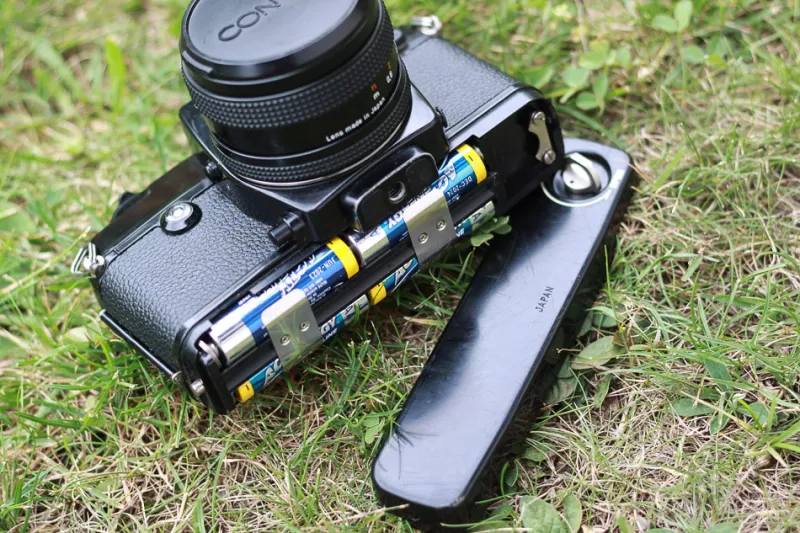
The Contax 137 MD in hand
If you take the camera in your hand, the weight of the car is surprising. Pretty heavy for a plastic bomber. But the weight also speaks for the compactness and build quality inside.
Of course, the 4 AA batteries, or in my case 4 rechargeable batteries, make a difference compared to 2 button cells, as in other cameras, but even without batteries it won’t be a lightweight.
Nevertheless, the 137 MD feels good in the hand. All buttons and switches are easily accessible and logically described, so that a look at the instructions can safely be omitted.
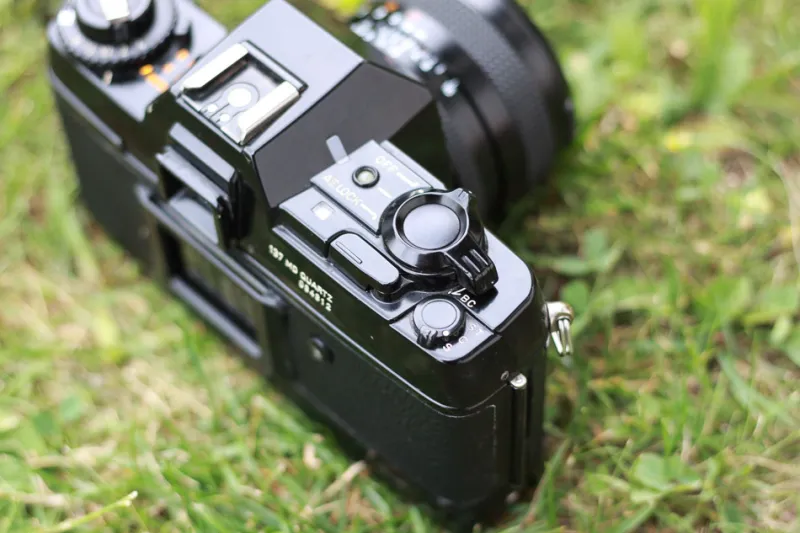
Special feature exposure correction
On the other hand, there aren’t that many buttons and switches either. Since the camera only has one mode, namely aperture priority, also known as A mode, there is no shutter speed dial.
At most, Bulb or the manual flash sync time of 1/60s can be set, nothing more. In most cases, the mode dial will probably stay on “Auto”.
In the same place, on the left shoulder of the camera, there is also the ISO dial and, for those times something special, an exposure compensation wheel.
What should be emphasized about the exposure correction is the fact that not only can corrections be made in whole apertures, but also the intermediate steps can be set, depending on how far you turn the wheel.
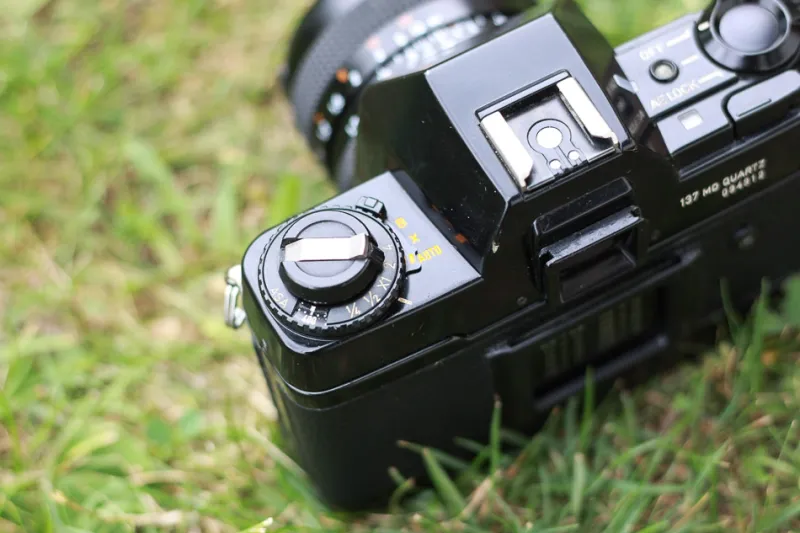
MD – MotorDrive
On the right shoulder is the on/off switch, which is also the battery test lever and AE lock lever. In addition, a frame counter and a switch from single frame to continuous frame or self-timer.
There is also a special feature on this side, because since the bottom of the camera has to serve entirely as the battery compartment, the release lever for film rewind is located at the top, under a small hinged protection, so that it is not accidentally pressed.
There is no film transport lever, since a micromotor takes over this work. Hence the name Contax 137 MD (MotorDrive). Rewinding, on the other hand, still has to be done manually.
All in all very logical and above all intuitive. It’s really fun to take pictures with the camera. Somehow a mix between the classics of the 70s and the fully automatic cameras of the 90s. In this case I think it’s a good mix.
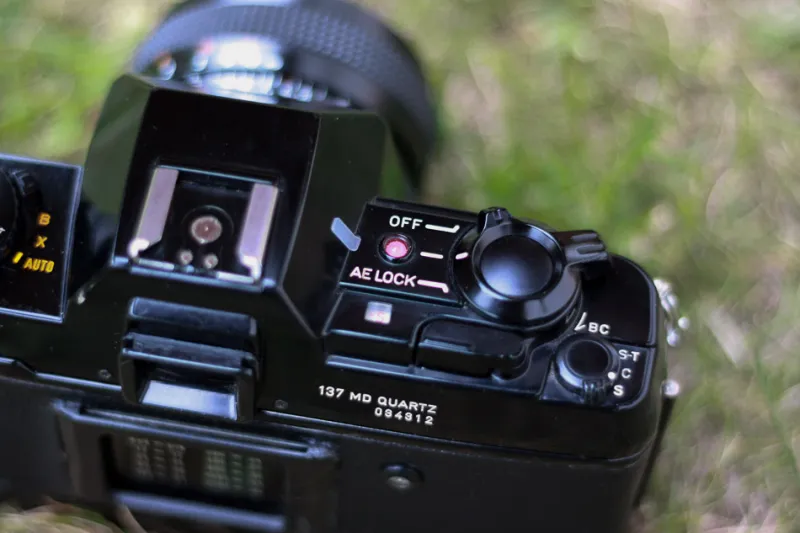
Operation of the Contax 137 MD
Maybe I just like the camera so much because it’s an incredibly cheap opportunity to use Zeiss lenses.
But maybe it’s also the consistently jagged and problem-free operation of the camera. After all, everything happens in “real time”.
The viewfinder also contributes to this no-frills experience. Anyone who has read one of my other reviews knows that I like viewfinders that are as large and bright as possible. And that’s exactly what the Contax 137 MD offers.
Extremely tidy with all the important information, just the way you want it. Times on the right, aperture up, frame counter on the left. The 0.86x magnification makes focusing easy.
You could shoot an entire movie without taking your eye off the viewfinder. Top notch!

Conclusion
I could get all those great Zeiss lenses and a couple of spare Contax 137 MDs and be happy for the rest of my life. On the other hand… actually a good 50 is enough for most cases.
In addition, the environment is just as happy as I am if rechargeable batteries can be used with the Contax instead of batteries. A resale of the Contax was planned, but this has been postponed for the time being.
In addition to the Leica M6, I was still missing an SLR, which I really like. Until then, I’ve found it. For now.
